|
All 5 books, Edward Tufte paperback $180
All 5 clothbound books, autographed by ET $280
Visual Display of Quantitative Information
Envisioning Information
Visual Explanations
Beautiful Evidence
Seeing With Fresh Eyes
catalog + shopping cart
|
Edward Tufte e-books Immediate download to any computer: Visual and Statistical Thinking $5
The Cognitive Style of Powerpoint $5
Seeing Around + Feynman Diagrams $5
Data Analysis for Politics and Policy $9
catalog + shopping cart
New ET Book
Seeing with Fresh Eyes:
catalog + shopping cart
Meaning, Space, Data, Truth |
Analyzing/Presenting Data/Information All 5 books + 4-hour ET online video course, keyed to the 5 books. |
My colleagues and I greatly enjoyed your New York seminar. As you showed us your Euclid and Galileo, I wondered which came first, your interest in visual information or your rare book collection?
I am looking forward to applying your principles to our work... thank you!
-- Mia Miller (email)
I have always tried to have personal copies of research and teaching materials. As an undergraduate in the 1960s I spent lots of time xeroxing course materials rather than reading in the library. In graduate school I got a student loan for my big annual xerox budget. This idea of having all the information in hand developed fully around the time of The Visual Display of Quantitative Information, when I started collecting Marey, Playfair, Minard, data atlases, and also fine press books (beautifully illustrated or printed books, an interest inspired by designing and self-publishing my own books).
These predispositions were accelerated by visits to the Beinecke Rare Book Library at Yale University, where I taught. I made the mistake of going there in my Levis, or something insufficiently tweedy anyway, and even though I was a full professor, a snooty research librarian made it clear that the Beinecke preferred more refined sorts interested in more humanistic matters rather than science, statistical graphics, and displays of evidence. (I later mentioned all this to the Director, who thought my stories quite amusing.) Also that library had weird and arbitrary policies about showing books to students while teaching seminars at the library--only a small number of books per seminar and the books could be touched only by a curator (who knew nothing about the content). To top it off, the photographic department was weak, routinely producing poor images, useless for high-quality publishing work. Nearly every policy and action reduced access to the wonderful books imprisoned at the Beinecke; it was a book collector's monument with untouched trophies on the shelves, rather than a research library. Of course I should have diplomatically worked my way around these impediments to learning.
At any rate, I made my own library, The Library of the Museum of Cognitive Art.
So, as Envisioning Information was underway, I collected maps, Japanese works of all sorts, evidence displays from legal cases, history of science books (Euclids, Galileo, Scheiner), books on color (Albers, Chevreul), typography, and nearly all the other material used in Envisioning Information.
And similarly for the next book, Visual Explanations.
And again for my current manuscript, Beautiful Evidence.
The originals are enormously inspiring. It is also straightforward to make high quality reproductions and scans for publication from our original copies, much better than photographs of books supplied by libraries.
Also original copies of great books are inspiring to students--the physicality, the longevity, the powerful ideas in the book. That is why I show the books in the one-day course. It is always wonderful to see a book by Galileo, to see the only time in print where Galileo said that the Earth moves, or to see Playfair's invention of the barchart, or Albers' demonstrations of interacting colors.
Over and over, these books indicate the timelessness of ideas about information design; they say that information design is about more important things than the difference between release 3.0 and release 3.1.
Some of the books also suggest that real smart people have thought hard about displays of evidence--for example, Galileo, who carefully watched over the design and publication of both The Starry Messenger (1610) and Letters on Sunspots (1613). Galileo personally financed the engravings in The Starry Messenger rather than using coarse woodcuts to report his amazing findings.
-- Edward Tufte
ET- Your books are always wonderfully illustrated with drawings and images drived from rare books. Your recent postings of chapters from "Beautiful Evidence" continues this practice. I'm wondering if you and/or your readers would share suggestions on scanning techniques and scanner technology. What works - what doesn't. Thanks, Daniel Meatte
-- Daniel Meatte
Good news! Cambridge University Press is reissuing William Playfair's "Commercial and Political Atlas" and his "Statistical Breviary". Information can be found at:
http://www.cambridge.org/uk/catalogue/catalogue.asp?isbn=0521855543
Michael Round
-- Michael Round (email)
William Playfair's "Commercial and Political Atlas" and his "Statistical Breviary"
My copy of the reproductions just arrived. Its pages are 6"x9" and many of the charts fold out to 11"x9". I thought at first that sloppy printing allowed the charts to bleed onto the facing pages, but a closer examination revealed that those and other minor defects were accurately reproduced from the University of Pennsylvania's original editions. It includes a 35-page introduction covering Playfair and his works.
Most revealing is that every chart is accompanied by 2 to 6 pages of discussion by Playfair-- all without bullets.
-- Dave Nash (email)
I just attended your seminar in New Jersey and thoroughly enjoyed it. I was particulary interested in your collection of rare books as well. I am a graphic designer and have studied early typography and book binding. In doing my studies I came a across a site that digitizes rare books and manuscripts for research purposes. I found this site particularly useful because I could not gain access to many of the books I wanted to examine closely. I have purchased a few digital books from them and was amazed at the quality of the high res PDFs they supply. You can view sample pages online from books such as, Albrecht Durer | De Symmetria, The Gutenberg Bible, Galileo Galilei | Sidereus Nuncius, etc. The link is: www.octavo.com
-- Tom Severini, September 26, 2005
-- Tom Severini (email)
Yale University Press has just released a revised edition of Josef Albers' "Interaction of Color," still in paperback though in a format slightly larger than previous paperback editions and with about twice the number of the color plates. Truly a bargain at 15 bucks. http://yalepress.yale.edu/yupbooks/book.asp?isbn=0300115954.
Also of note, Albers' "Formulation:Articulation," originally a suite of prints from 1972. A facsimile edition will be issued later this Spring, in hardcover, by Thames and Hudson at ??60 or $100 US. http://www.thameshudson.co.uk/en/1/9780500238288.mxs?85ba3e87bf542ae774ccc1e9563ef9f8&1&1&9780500238288.
-- Steve Sprague (email)
Dear ET,
I recently purchased several of the suggested readings from your seminars. Thank you for the recommendations. They all complement your writings and offer a deeper understanding of design.
However, I was disappointed these classics often do not follow some of the principles of good book design that your books exemplify. For example, reading Albers' "Interaction of Color" requires constant flipping from the front of the book to the end to examine the relevant color plates, and the numbering of the plates is not immediately logical. Norman's "Psychology of Everyday Things" employs, to my eye, unpleasant lengthy passages in italics.
I wondered if you and your team would consider re-working these classics in a way that would leave their content intact but would make for more pleasant reading? There are copyright issues to attend to but perhaps the authors of those books still under copyright would welcome your suggestions for later editions?
Such an effort would be akin to E.B. White's revisions to William Strunk's original content, resulting in the edition of "The Elements of Style" that we read (and annually re-read) now.
-Eric Howell
-- Eric Howell (email)
Rare Book Room
This website (http://www.rarebookroom.org/) has a great collection of high resolution images of rare books covering arts, history and science. For each book there is a viewer with thumbnails that allow you to browse through two page spreads. You can then zoom in to quite a high resolution. The books are phtographed from start to finish so you can appreciate the bindings, frontispiece, diagrams and text and how thay all interrelate.
This is quite a treasure trove. As an example, you can find a complete set of page view images from Robert Hookes splendid book on microscopy, Micrographia, which was published in London 1664.
I have seen some of the images from this book before, but never in their proper context, nor at such high resolution. The images below show the spread of pages 114 and 115. The text on page 115 shows some of his explanation of how he obtained these images of cork cells.The figure on page 114 shows Hookes drawings of longituidinal and transverse sections through cork and where he obtained the sample (Hooke found these small separated structures reminded him of the cells of monks and he used that term to describe them - they have been called cells ever since).
Matt
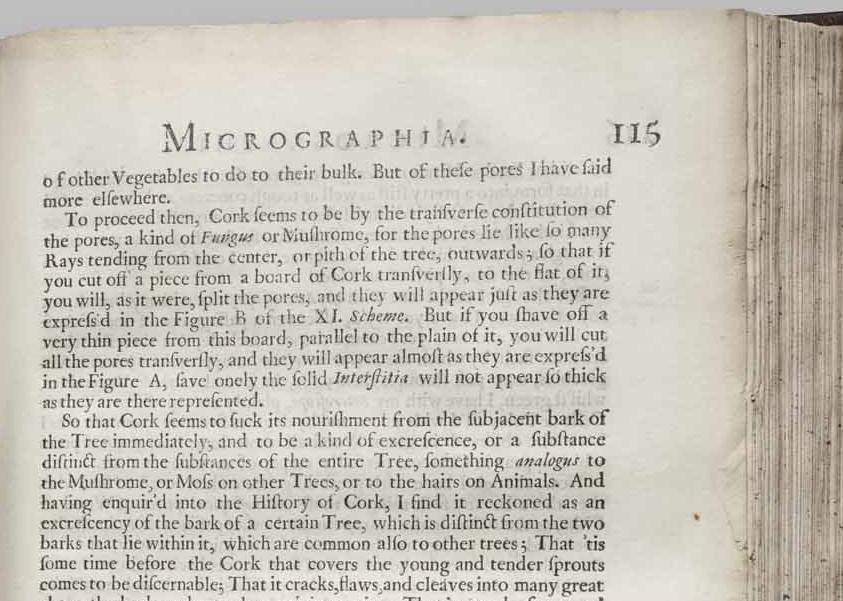

-- Matt R (email)
Dear ET,
I was browsing my books recently and found my modern reprint copy of 'On Growth and Form' by the great naturalist D'Arcy Wentworth Thompson. I had never seen any mention of him on this forum and wanted to mention him. He was a classicist, mathematician and zoologist. The book, originally published in 1917, is a brilliant collection of data graphics, prose and quantified images.
One of his best know ideas is that simple physical deformations of complex systems can give rise to whole families of apparently unrealted natural forms. The image shown below is page 744 of the first edition (you can find the whole book in electronic form at the Internet Archive = http://www.archive.org/details/ongrowthform1917thom). It shows how a complex shape representing the 2D shape of a crabs carapace can after simple geometric transformations give rise to a family of different carapace shapes.
Best wishes
Matt R
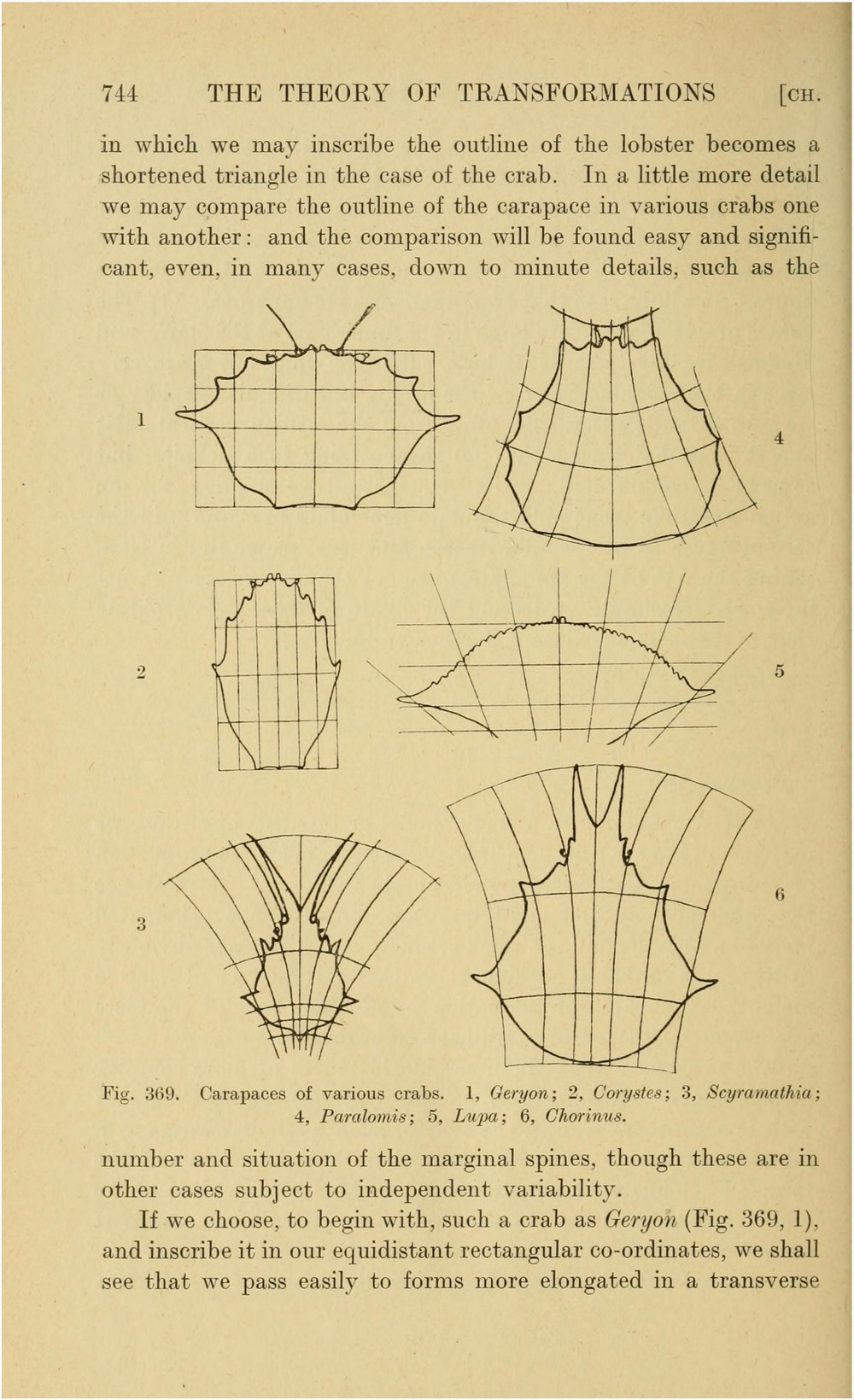
-- Matt R (email)
Here is a link to a small British printing press, the Old School Press in Bath, that is using traditional letterpress and binding techniques to make small runs of high quality books - both re-prints of older material and new books.
This link = http://www.theoldschoolpress.com/osppic/bookfellrevivalinside.htm is to a book published by them called "The story of the revival of the Fell types in the 125 years from 1864" by Martyn Ould and Martyn Thomas, which describes and uses the type punches and matrices designed by John Fell and used by Oxford University Press - these original punches and types were rediscovered at O.U.P. in the the 1860s and this tells the story of how they were used and shows some of the output.
Best wishes
Matt
-- Matt R (email)
Dear ET,
further to my last email here is a picture diary describing exactly how the Old School Press made their first book - "The Bricks of Venice" by John Ruskin = http://www.theoldschoolpress.com/osppic/ospatwork/makingBOV1.htm.
The image below is one of the first pages of chapter 3, Crenellations. It has some large Bembo italic for the chapter number and title.
Best wishes
Matt
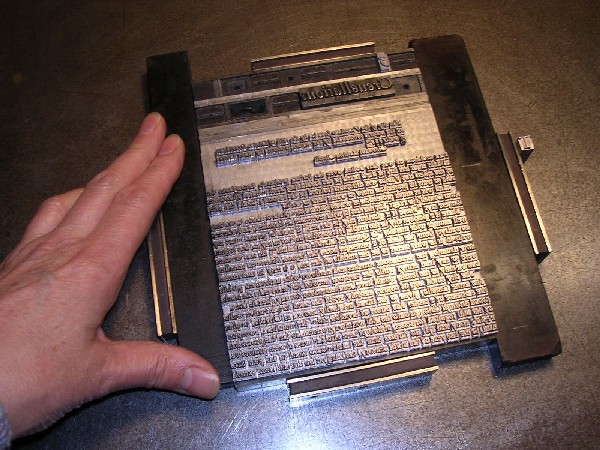
-- Matt R (email)
Dear ET,
here is a very high resolution scan of a specimen sheet issued by William Caslon, letter founder, from the 1728 edition of Cyclopaedia (http://en.wikipedia.org/wiki/File:Caslon-schriftmusterblatt.jpeg).
The book itself is here (http://digicoll.library.wisc.edu/HistSciTech/subcollections/CyclopaediaAbout.html)
Best wishes
Matt
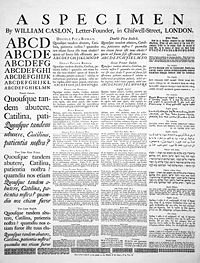
-- Matt R (email)
Dear ET,
Here is a very detailed collection of images from the Posner collection of books at the Carnegie Mellon University (http://posner.library.cmu.edu/Posner/).
Details:
"The Posner Memorial Collection of six hundred twenty-two titles includes landmark titles of the history of western science, beautifully produced books on decorative arts and fine sets of literature. Mr. Henry Posner, Sr. formed the collection from 1924 to 1973, starting with literature and decorative arts and, after 1950, focusing on the history of science. When possible, books are in electronic format with text and images and accompanied by a Collector's File of Mr. Posner's records."
One of the books in the collection is a very rare book by Johannes Kepler. Kepler was a brilliant mathematician and mathematical physicist who is chiefly remembered for discovering the three laws of planetary motion that bear his name. However, Kepler also did important work in optics, close packing of spheres, logarithms and solid geometry.
One of his lesser known works was prompted by a problem he had encountered whilst buying wine after his second wedding celebration in 1613. Kepler noted that the vintner measured the capacity of the wine barrel by putting a stick into the bung hole and measuring the distance to the bottom of the barrel. It struck Kepler that the crude `dipstick' method of estimating the volume of the barrel wouldn't take into account the curvature of the barrel and would thus give an inaccurate estimate of the volume. Prompted by this observation Kepler made a careful study of the general problem of accurately estimating the volume of wine barrels and other solids of revolution. Kepler's solution was to divide the barrel into a large number of slices and estimate the total barrel volume by summing the volumes of the individual slices. Kepler's work was published in 1615 as Nova Stereometria Doliorum Vinariorum, which roughly translates to `New Measurements of Wine Barrels'.
The Nova Stereometria is a rarity and has never been translated into English. However, although it's technical content is little known to non-specialists it has become a sought after commodity amongst book collectors; a mint condition copy of Kepler's book in its original binding will sell for upwards of $30,000.
Keplers work was an important precursor to the calculus.
Here is the title page of the Posner copy of Nova Stereometria.
Best wishes
Matt
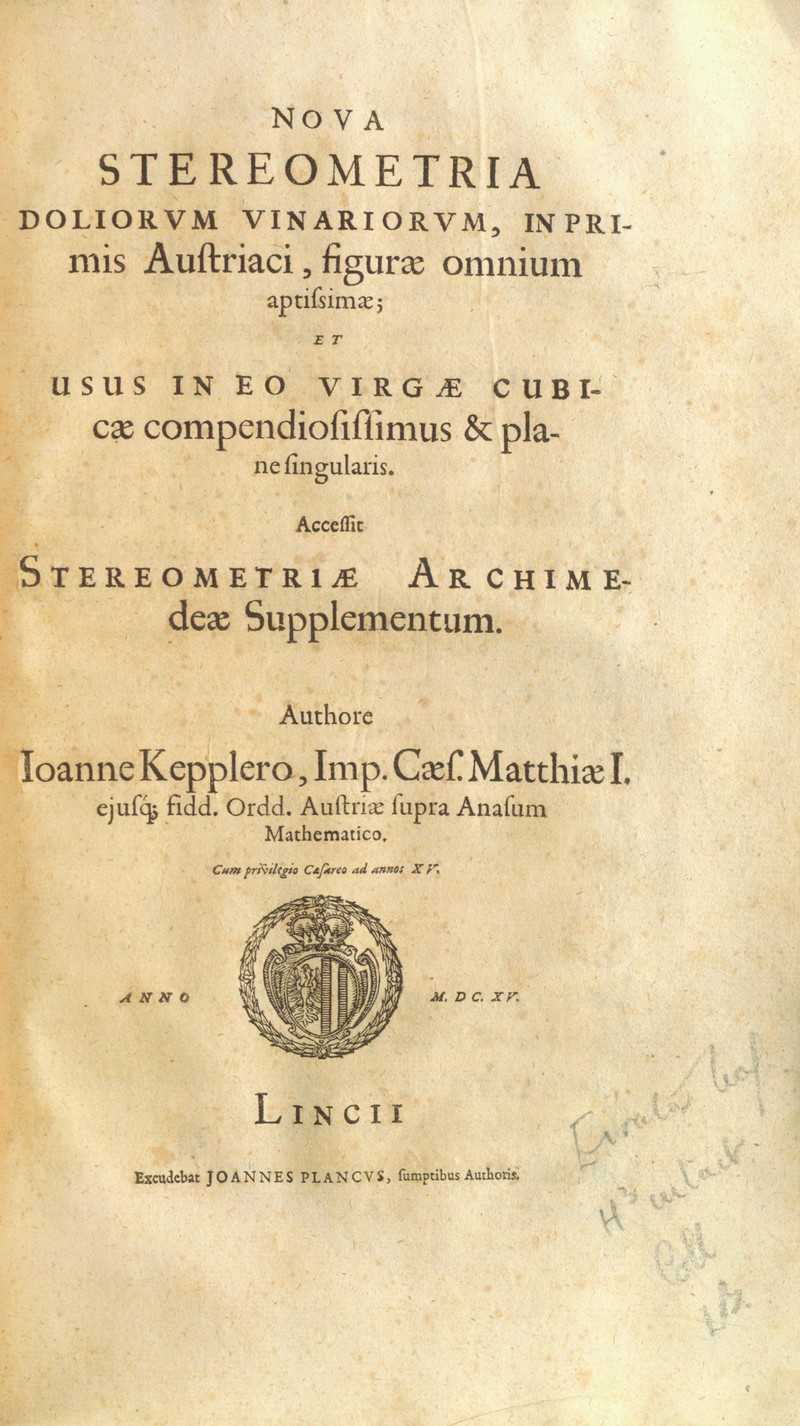
-- matt R (email)
Taschen has published a facsimile edition of Oliver Byrne's 1847 The Elements of Euclid, beautifully treated it Envisioning Information, in a boxed set with a separate commentary by art historian Werner Oechslin. Scheduled for release this May. See it at http://www.taschen.com/pages/en/catalogue/classics/all/06724/facts.byrne_six_books_of_euclid.htm?utm_source=tas&utm_medium=nl&utm_campaign=2010_4
-- Steve Sprague (email)
I think folks here may also enjoy this example from the world of music: seeing how Mozart integrated his notes and music in this diary of his....you'll notice he uses the left page only for text and the right page only for music, but all text is numbered sequentially and dated and aligned with the musical notes on the right hand side....
the following is an excerpt from the British Library press note online that describes the entries in the diary:
....(begin extract:) "Presented to the British Library by the heirs of the writer Stefan Zweig in 1986, the Verzeichnuss aller meiner Werke gives details of 145 works written by Mozart from February 1784 until his death in December 1791. On the left-hand side of each page Mozart entered five compositions, each with the date on which it was completed, the title and usually its instrumentation. Further details such as the name of the singer, where it was composed or who had commissioned the piece were also sometimes included. Mozart divided the right hand page into five pairs of staves on which he wrote the opening bars of each work. The last 14 openings in the manuscript were poignantly left blank after Mozart died".....(end extract) source:http://www.bl.uk/news/2005/pressrelease20051208.html
The diary itself can be seen online here: http://www.bl.uk/onlinegallery/virtualbooks/viewall/index.html#
(Note to the editor/moderator: Please edit as required for compliance to any copyright issues/laws. I have therefore provided the source links)
-- Albert Lewis (email)
This morning's New York Times has a very interesting article about the Rare Book School at the University of Virginia, Peering Into the Exquisite Life of Rare Books.
I enjoyed attending a recent Boston seminar of yours, your obvious love of first editions of wonderful books makes me believe you would enjoy attending this.
-- Bernard Farrell (email)
|
||||||||

